Acoustic Instrument
Primers
What Kind of Guitar
Should I Start On?
What Kind of Banjo
Do I Want?
Evaluating and
Buying Used
Guitars
Setting Up
Fretted Instruments Whatever Happened
to the Banjo?
Beginning Five-
String Banjo
6-String Banjos
Banjo Pickups
Axes in my Life
What is a
Bluegrass Banjo?
Dean "Backwoods
Six" Shootout
Music Theory
Primers
Introduction
to Scales
Introduction
to Chords
Circle of Fifths
Other Articles
About Music
How to Give
Guitar Lessons
Musician or
Wannabe? Did God Really
Give Rock &
Roll to You?
Are You a
"Brand Bigot"?
Who Owns Folk Songs?
Historical Links
About the
National Road
The Story Behind
the Story - Real
People, Places,
and Events
About the Play
Play Home
What's New
Overview
About the
Music
About the
History
About the
Logistics
About the
Cast
Synopsis
About the
Set
About the
Author
Contact Us
Home

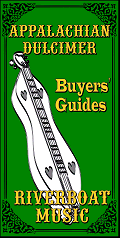
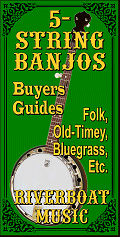

|

|
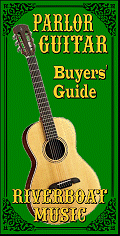
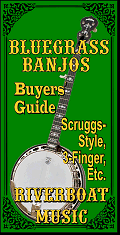

Beginning Five-String Folk Banjo - Part Fourteen - Modal Songs
| Written by Paul Race for Creek Don't RiseTM and School Of The RockTM |
Remember how, in Lesson 12, we said that the rules for chords minor keys are more complex than the "rules" for chords in major keys? Well, here's a look at other kinds of scale that have their own sets of rules.
If you're interested in "old-timey" or Celtic music, you should know this stuff. Even if you aren't, you should know something about it so if the topic comes up in a room full of people you're trying to impress, you don't say something stupid.
We're talking about songs in "modal" keys. A "mode" is a kind of scale. You've already met two modes. The Ionian mode is the same as the major scale. On a piano, an Ionian scale in the key of C would start on a C and hit all the white keys until it arrives at the next C.

The Aeolian mode is the same as the "natural minor" scale - that is a minor scale that keeps the same number of sharps and flats at the relative major it "belongs to." On a piano, an Aeolian scale would start on A and hit all the white keys until it arrives at the next A.

Trivia Time: If the mode names sound foreign, it's because they're borrowed from the work of the ancient Greek mathematician Pythagoras. He studied the relationship between notes of various ancient Greek scales. Today's "modes" are different than the ones he defined, but we use the same names he did.
The following table shows the mode that would relate to each "scale" played only on the white keys.
| Ionian | C to C |
| Dorian | D to D |
| Phrygian | E to E |
| Lydian | F to F |
| Mixolodian | G to G |
| Aeolian | A to A |
| Locrian | B to B |
For an exercise, sit down at a piano and play each of these scales up and down. You'll notice that:
- Ionian, Lydian, and Mixolodian sound basically major
- Dorian, Phrygian, and Aeolian sound basically minor
- Locrian just sounds weird - the scale includes a diminished triad, the only one on the keyboard.
 |
 |
 |
 |
 |
 |
 |
It is no surprise that some of these modes are almost never used. But many old folk songs use Dorian and Mixolodian, and some "classical" and Jazz composers use them all.
In fact, if you're going through these lessons in sequence, you've already learned one song in Dorian mode - "What do You do With a Drunken Sailor?" (from Lesson 12) If you do the song in the key of D minor like we did, the melody includes a B natural, which, technically does not "belong" in the key of D minor (it "should" be a Bb).

This song doesn't sound all that strange to our ears since we're used to it, and since it only has one note that "breaks the rules." But some modal songs have several notes that "break the rules."
Relationship of Mode to Key Signature - You may be used to thinking of a song that is in the key of C as having no sharps or flats. A song in A minor usually has no sharps or flats either, unless you're including accidentals for "harmonic minor" or "melodic minor." But with modes, the relationship between key signature and key may not be obvious. For example, what if your song seems to be in the key of G but there is no F# (as there usually would be)? It's possible that the arranger made a mistake. But it's also possible that the song is in Mixolodian mode.
Relationship of Mode to Chord Progression - A modal tune may require adjustment to our typical "1/4/5" chord progressions. For example, an "Ionian" tune in the key may include the note F#. And it might be harmonized by going to a D or D7 chord. But a Mixolodian tune in the key of G will include F where you'd expect to hear an F#. You can't use D or D7, because that would clash. So you could stay on G and have a temporary G7 chord. Or you could substitute an F Major or D minor chord instead. In other words, the rules change.
In addition, you may have a song that sounds like it's in the key of C for the most part, but which ends on a G or even an F. Chances are the song was originally written in Mixolodian or Lydian mode, respectively.
Back when these tunes were written, chordal harmony was in its infancy; applying modern chord progressions against some of them just robs them of their charm or creates something that betrays the original composer's intentions. In some cases, the best you can do is what Appalachian dulcimer players used to do - have the melody playing against a drone note and leave the rest of the notes out.
Relationship of Mode to Tuning - Some banjo players like to retune their banjos slightly when playing certain modal tunes. One of the most common retunings is called "Sawmill" tuning, which tunes the second string up to C (DCGDg). For some songs this tuning has the advantage of taking the "third" out of the G chord, so you're not stuck playing major OR minor, the same way we use the Dno3rd in some of our previous lessons.
We'll be using a simple example that avoids retuning, but don't be surprised when you come across it.
Mixolodian Mode Example: "Old Joe Clark"
Old Joe Clark is a fiddle/barn dance tune with at least three different choruses and probably a hundred verses, all nonsense. It's also harmonized and accompanied about thirty different ways, although certain players will tell you they play the only "right version."For the sake of this lesson, we're going to show you three different ways you could accompany this. I won't promise that you won't find a tablature someday you like better, but these are all three perfectly legitimate. Also, you'll find different versions of the words wherever they're posted. For songs like this, neither the accompaniment nor the words are important - the melody is the only thing that's non-negotiable.
One-Chord Accompaniment - We're going to start with a method that was quite popular in barn dances a century ago, keeping the whole song in one chord. We'll start out with the key of G which is hard for some people to sing, but easy to play.
 For now we'll also use our basic alternating bass G pattern - no Blues notes or Bluegrass licks. For a reminder of what this pattern sounds like, click this logo:
For now we'll also use our basic alternating bass G pattern - no Blues notes or Bluegrass licks. For a reminder of what this pattern sounds like, click this logo: 
In case you don't know the melody, here it is in the key of G. To see sheet music with just the melody, click the little score below. To hear an mp3 of the tune with the simple accompaniment shown above, click this logo: 
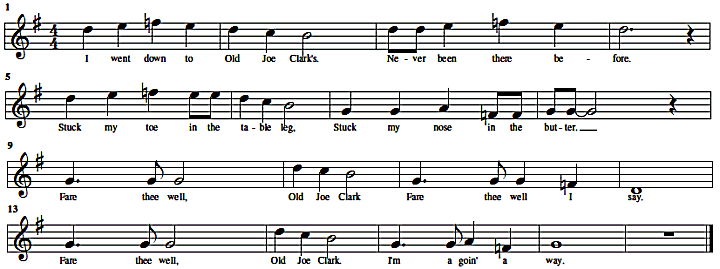
If you want to see sheet music with the banjo tab written out, click here.
Adding Other Chords - You'll notice that the high F in the first line doesn't quite seem to fit, but it comes and goes so fast that it's not a big problem. The low F in the last line of the chorus and the last line of the verse is a little more prominent. In some Mixolodian songs, folks would put an F chord there. Again, this could be seen as a substitute for D7 which would be the dominant of the song if only its F# didn't clash with the melody.
 On the other hand, we notice that the low D at the end of the second line could be used as an excuse to get off the G chord. The D minor chord also includes an F so it works to plug a D minor chord into those places.
On the other hand, we notice that the low D at the end of the second line could be used as an excuse to get off the G chord. The D minor chord also includes an F so it works to plug a D minor chord into those places.
Technically, the "D minor" chord we are using has a "suspended fourth" because of the high G playing on the fifth string, but that note is so ubiquitous in this song that it doesn't even "register" as part of the chord.
For this exercise, we have written out the banjo tab. To see it in sheet music format, click the little score below. To hear an mp3 of the tune with the D minor added, click this logo: 
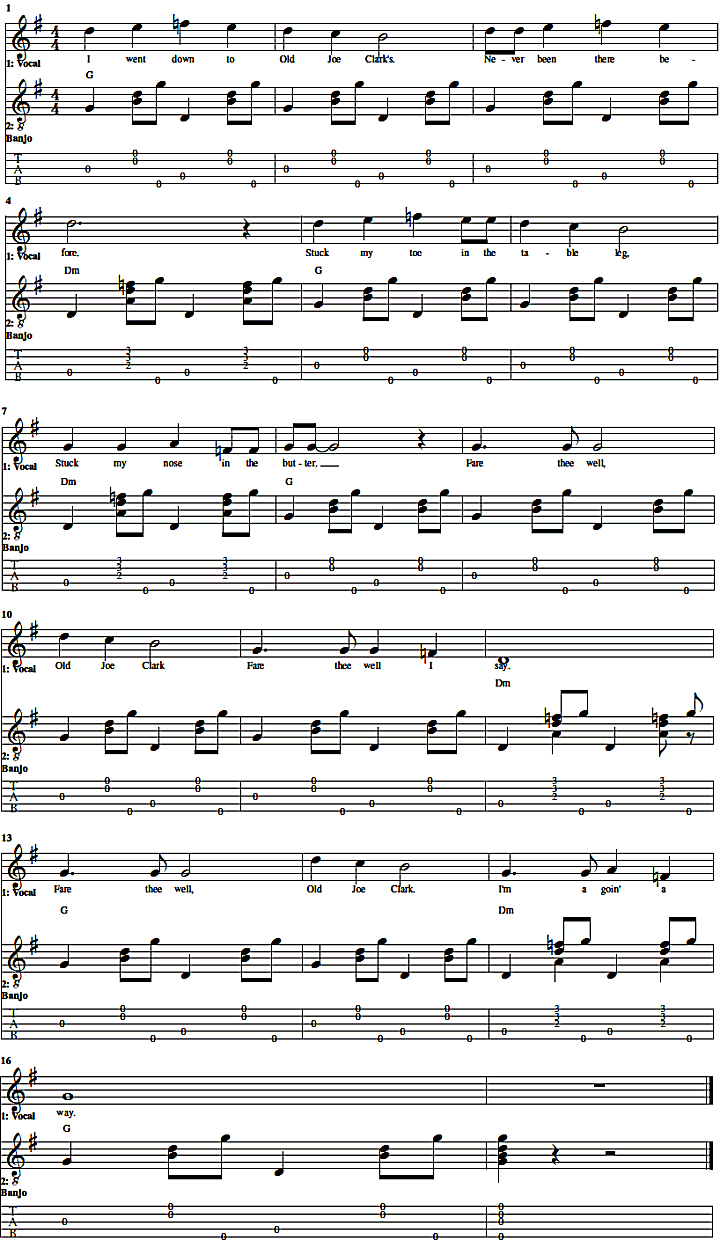
 Substituting Dno3d - To some people, the D minor chord in this arrangement might seem a little "heavy-handed." To others it may seem awkward to play. No worries. In the key of G, you can easily substitute Dno3rd. By removing the F, you allow the listeners' own preconceptions to decide whether they're hearing a minor chord or not. And it's frankly easier to play. To my ears, playing the same note on the second and first string simultaneously adds a little bit of "mountain" feel to the thing.
Substituting Dno3d - To some people, the D minor chord in this arrangement might seem a little "heavy-handed." To others it may seem awkward to play. No worries. In the key of G, you can easily substitute Dno3rd. By removing the F, you allow the listeners' own preconceptions to decide whether they're hearing a minor chord or not. And it's frankly easier to play. To my ears, playing the same note on the second and first string simultaneously adds a little bit of "mountain" feel to the thing.
 In the score above, simply substitute the measure to the right wherever the Dm chord appears. To hear an mp3 of the tune with the D minor added, click this logo:
In the score above, simply substitute the measure to the right wherever the Dm chord appears. To hear an mp3 of the tune with the D minor added, click this logo: 
If you want to see sheet music with the banjo tab written out, click here.
Solo Version - There are as many ways of taking a solo on this song as there are banjo players. Plus you should know that if you have a fiddle in the group, they'll probably play the song in some other key (see below for a few examples). But we like giving you solos to practice, so here's one simple version in G. To hear an mp3 of this arrangement, click this logo: 

Other Keys - This song is, frankly easier for most people to sing if it's put into D or C.
|  | 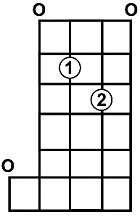 |  |
|  | 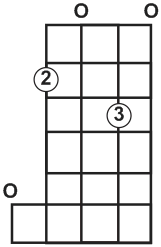 |
Conclusion
This is just an example of how you might experiment with different chord progressions when harmonizing a truly modal tune that has survived into our day. Fortunately, most of them are documented somewhere, and many of them are tabbed, so you won't necessarily be on your own.In addition to tunes that are still written in modes, many folk songs that started out in unusual modes have evolved to more traditional scales. In some cases, folks transcribing them didn't "get" the original tune. In others, singers who wanted to use post-1800 harmonic structures changed the melodies around to fit. If you're interested in a tune that "sounds" modal but isn't quite, you could try looking for an older version of the thing, or even reconstruct it as modal yourself.
Performances and transcriptions by traditional Appalachian dulcimer performers like Jeannie Ritchie and John Jacob Niles often retain the old modal structures, because the instruments they were using couldn't play those song any other way. (Modern instruments have more frets so you can still play modally, but you don't have to.)
In the meantime please contact us if you have any questions or hit any brick walls.
All material, illustrations, and content of this web site is copyrighted © 2001, 2002, 2003, 2004, 2005, 2006,
2007, 2008, 2009, 2010, 2011, 2012, 2013, 2014, 2015 by Paul D. Race. All rights reserved.
Creek Dont' Rise(tm) is a participant in the Amazon Services LLC Associates Program, an affiliate advertising
program designed to provide a means for sites to earn advertising fees by advertising and linking to Amazon.com.
For questions, comments, suggestions, trouble reports, etc. about this play or about this web page, please contact us.
| Visit related pages and affiliated sites: | ||||||
| - Music - | ||||||

|
 |
 |

|

|

|
|

|

|

|

|

|

|
|
| - Trains and Hobbies - | ||||||
 |

|

|  |
 |

|
|
| - Christmas Memories and Collectibles - | ||||||
 |

|
 |

|
 |

|
|
| - Family Activities and Crafts - | ||||||
 |

|

|

|

|

|
|
